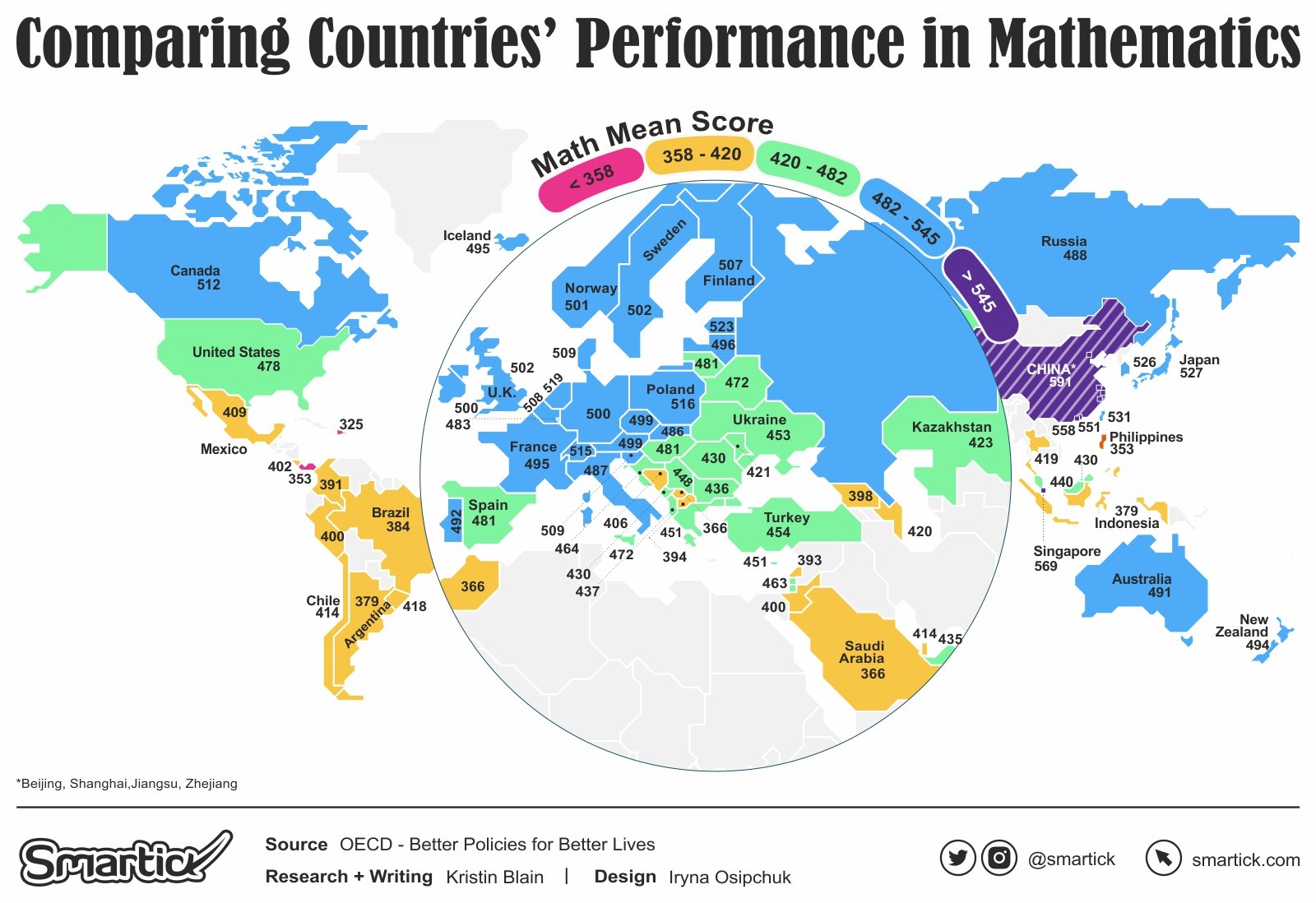
Despite a spectrum of cultural differences around the planet, the pursuit of excellent education is a common goal in nearly every society. Countries understand how well-educated citizens support and uplift their nations’ economies, and math achievement is a keystone to such economic success. However, according to scholastic achievement data collected by the Program for International Student Assessment (PISA) the standard for math achievement varies greatly across borders.

Top 10 High-Performing Countries in Math
| Rank | Country | Score |
|---|---|---|
| 1 | China | 591 |
| 2 | Singapore | 569 |
| 3 | Macao (China) | 558 |
| 4 | Hong Kong (China) | 551 |
| 5 | Taiwan | 531 |
| 6 | Japan | 527 |
| 7 | South Korea | 526 |
| 8 | Estonia | 523 |
| 9 | Netherlands | 519 |
| 10 | Poland | 516 |
According to the PISA report in 2018, mainland China takes the cake for first place in math achievement with an overall score of 591 points. Singapore, Taiwan, Japan, and South Korea follow up in the rankings with scores ranging from 526 to 569 points.
Historically, China and its neighboring nations have carried the title in academic success—especially in math. Some studies suggest that these high performance rates have a foundation in work ethic. Chinese children are socialized to tackle difficult problems and work through them, and this type of growth mindset often leads to deeper learning. Researchers have also shown that Chinese language acquisition is tied to the Chinese numerical system in a way that affects how quickly Chinese children are able to work with numbers and sums.
Despite this data, math scores on international assessments can’t always be counted on as a true reflection of a nation’s scholarship. Researchers have argued that there is not one but two Chinas: an urban China rapidly cultivating wealth, and a rural China mired in poverty. Students from the urban provinces of Beijing, Shanghai, Jiangsu, and Zhejiang are the sole participants of PISA testing, implicating a skewed perspective of the academic achievement of the country as whole, given that 37% of the nation’s population resides—unrepresented— in rural China.
This understanding reinforces the long-understood relationship between socio-economic standing and academic achievement. Simply put, students from affluent backgrounds tend to do better in school.
Bottom 10 Lowest-Performing Countries in Math
| Ranking | Country | Score |
|---|---|---|
| 1 | Dominican Republic | 325 |
| 2 | Phillippines | 353 |
| 3 | Panama | 353 |
| 4 | Kosovo | 366 |
| 5 | Morocco | 368 |
| 6 | Saudi Arabia | 373 |
| 7 | Indonesia | 379 |
| 8 | Argentina | 379 |
| 9 | Brazil | 384 |
| 10 | Colombia | 391 |
Of the 78 countries that participated in the 2018 PISA evaluation, the Dominican Republic took last place with a score of 325–a full 28 points behind the penultimates Philippines and Panama with equal scores of 353, and a staggering 164 points behind the global average. With scores of 366 and 368 respectively, Kosovo and Morocco also found themselves at the tail-end of the race. Scarce funding, rural living, oversized classes, and gender inequality are all major contributors to these gaps in math achievement.
The Dominican Republic is known for having one of the most underperforming education systems in the world. Despite public education funding targets set at 4% of the country’s GDP, only about 2% has been dedicated to the much-needed reforms. Class sizes tend to run far above 30 students and teachers are paid so little that they cannot earn a living, making the vocation unappealing to the mere 23% of the nation’s new university graduates. About 40% of students drop out before reaching eighth grade, and one in four girls drop out due to pregnancy.
Despite its last place in the race, efforts are being made for this Caribbean nation—and other nations like it—to improve access to quality education. Thanks to the diagnostic data such as those collected by PISA, the World Bank boosted education reform by financing $100 million to the Ministry of Education in the Dominican Republic in 2018.
Mitigating Disparities in Global Math Achievement
For many countries struggling with their students’ math achievement, equal access to quality education remains the greatest hurdle. However, in order to increase the pace of improvement and reach more students, current approaches to global equity in education must be fundamentally rethought and restructured.
Technology and its infrastructures (such as universal internet access) have the potential to make learning opportunities more widely accessible, decreasing the detriments of geographical boundaries and bringing quality education to millions of children in need, including marginalized girls. For many children around the world struggling with sums, the road to higher math achievement could be just one click away.

